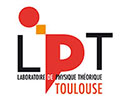Electron-skyrmion interaction in a Néel antiferromagnet, and combined study of classical spin liquids families
Interaction entre un électron et un skyrmion dans un aimant présentant un ordre Néel, et étude combinée de familles de liquides de spin classiques
Résumé
The present manuscript treats two distinct subjects, having nevertheless for common points the fact that these subjects speak about magnetism and topology, and that we treat them both almost exclusively in an analytical way. The first subject concerns the study of the behavior of an electron in a two-dimensional material hosting an antiferromagnetic Neel order. We are particularly interested in the case where this material is covered by a very particular defect called skyrmion, intrinsically carrying a topological charge. The study focuses on the interaction of the electron considered with the skyrmion, the case of a ferromagnetic material having already been studied and having revealed that the electron is scattered by the skyrmion, and that this scattering depends on the orientation of the spin of the electron and the topological charge of the skyrmion. The antiferromagnetic case turns out to be richer, since we certainly witness a potential scattering of the electron by the skyrmion involving again the electron spin, but also the possibility of the existence of electron-skyrmion bound states. We show in particular that the spatial structure, the energy and the existence of such bound states depend on the profile of the skyrmion considered. We start by constructing a quantum description of the electron-skyrmion interaction, before applying it to different relevant profiles, in order to illustrate the different physical consequences of this interaction. It appears that the number of existing bound states increases with the spatial extension of the skyrmion, and that the spatial and energetic structure of these states depends very strongly on the skyrmion profile studied. Contrary to what intuition suggests, bound states existence results in a global energy cost for the skyrmion and not a gain. This energy cost also appears to be strongly dependent on the spatial structure of the skyrmion, and will therefore favor some skyrmion profiles. It also appears that the pairing of a skyrmion with electrons modifies the optical absorption properties locally around the skyrmion, allowing a potential detection of antiferromagnetic skyrmions thanks to this property, based on the interaction with electrons. The second topic is about classical spin liquids, a state of matter having very peculiar properties and having attracted a lot of attention during the last years. We are particularly interested in a family of Hamiltonians, having the particularity to be defined on spin clusters, and likely to host such states. We focus on different analytical and numerical methods to identify and characterize the different classical spin liquids obtained within this family. These methods are applied to three different systems presenting differents types of clusters placed on different lattices, allowing to illustrate on the one hand the efficiency of these analysis tools, and on the other hand the richness of the spin liquids generated by this family of Hamiltonians. Some specific characteristics of the observed spin liquids are studied in detail, thus serving as case studies for these novel cases.
On s'intéresse dans ce manuscrit à deux sujets distincts, ayant tout de même pour points communs le fait que ces sujets parlent de magnétisme et de topologie, et qu'on les traite tout deux quasiment exclusivement de manière analytique. Le premier sujet porte sur l'étude du comportement d'un électron au sein d'un matériau bidimensionnel hébergeant un ordre antiferromagnétique de Néel. On s'intéresse plus particulièrement au cas où ce matériau est habillé par un défaut bien particulier appelé skyrmion, portant intrinsèquement une charge topologique. L'étude se porte ainsi sur l'interaction de l'électron considéré avec le skyrmion, le cas d'un matériau ferromagnétique ayant déjà été étudié et ayant révélé que l'électron est diffusé par le skyrmion, et que cette diffusion dépend de l'orientation du spin de l'électron et de la charge topologique du skyrmion. Le cas antiferromagnétique se révèle ici plus riche, puisqu'on assiste certes à une potentielle diffusion de l'électron par le skyrmion impliquant là encore le spin de l'électron, mais aussi la possibilité de l'existence d'états liés électron-skyrmions. On montre notamment que la structure spatiale, l'énergie et l'existence de tels états liés dépend du profil du skyrmion considéré. On commencera par la construction d'une description quantique de l'interaction électron-skyrmion, avant de l'appliquer à différents profils pertinents, afin d'illustrer les différences conséquences physiques de cette interaction. Il apparaît que le nombre d'états liés existants croît avec l'extension spatiale du skyrmion, et que la structure spatiale et énergétique de ces états dépend très fortement du profil du skyrmion étudié. Contrairement à ce que pourrait suggérer l'intuition, de l'existence de ces états liés résulte un coût d'énergie global pour le skyrmion et non un gain. Ce coût énergétique se révèle lui aussi dépendre fortement de la structure spatiale du skyrmion, et favorisera donc certains profils de skyrmions au détriment d'autres. Il apparaît aussi que l'appariement d'un skyrmion avec des électrons modifie les propriétés d'absorption optique localement autour du skyrmion, permettant une potentielle détection des skyrmions antiferromagnétique grâce à cette propriété, reposant sur l'interaction avec les électrons. Le second sujet porte quant à lui sur les liquides de spin classiques, état de la matière ayant des propriétés très particulières et ayant attiré beaucoup d'attention pendant ces dernières années. On s'intéresse en particulier à une famille de hamiltoniens, ayant la particularité d'êtres définis sur des groupes de spin, et susceptibles d'abriter de tels états. On se concentre sur différentes méthodes d'analyses analytiques et numériques permettant d'identifier et de caractériser les différents liquides de spin classiques obtenus avec cette famille. Ces méthodes sont appliquées à trois hamiltoniens différents, permettant d'illustrer d'une part l'efficacité de ces outils d'analyse, et d'autre part la richesse des liquides de spin engendrés par cette famille de hamiltoniens. Certaines caractéristiques spécifiques des liquides de spin observés sont étudiées en détail, faisant ainsi office de cas d'études pour ces cas inédits.
| Origine | Version validée par le jury (STAR) |
|---|
